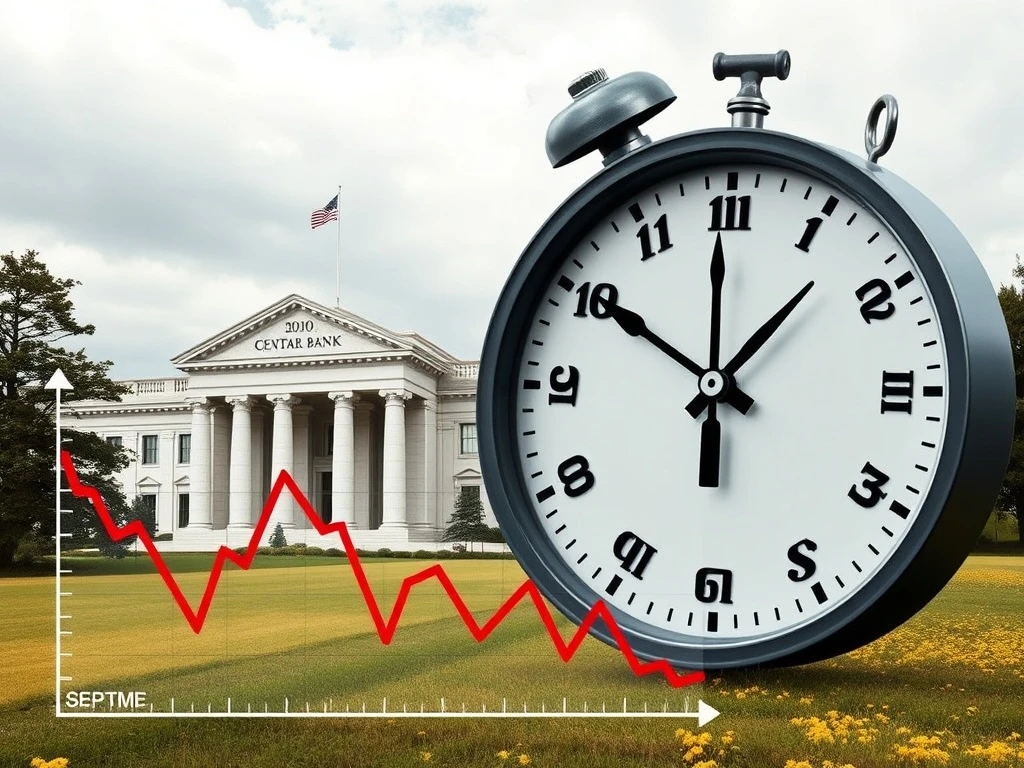Understanding the Federal Reserve’s actions is crucial for market participants. Specifically, the prospect of a large **Fed rate cut** often sparks intense debate. Many analysts believe a significant reduction in interest rates, especially an unexpected jumbo cut, could signal underlying economic distress. This article explores why such a move might be perceived as panicky and its potential implications for various markets.
The Significance of a Jumbo Fed Rate Cut
A **Fed rate cut** indicates the central bank’s response to economic conditions. Typically, the Federal Reserve adjusts the federal funds rate in measured steps, often by 25 basis points. A ‘jumbo’ cut, usually 50 basis points or more, is a far more aggressive intervention. Such a move suggests the Fed sees a rapid deterioration in economic health. Moreover, it implies standard adjustments are insufficient to stabilize the economy. This aggressive stance can ironically trigger market anxiety rather than calm it.
Historically, the Fed has resorted to jumbo cuts during periods of severe economic crisis. For instance, the global financial crisis of 2008 saw significant rate reductions. More recently, the early days of the COVID-19 pandemic prompted emergency rate cuts. Therefore, a large **Fed rate cut** outside of such obvious crises raises questions. It suggests policymakers might possess information about unseen economic vulnerabilities. Consequently, investors often interpret this as a sign of deeper trouble.
Why a Jumbo Fed Rate Cut Appears Panicky
Several factors contribute to the perception of panic surrounding a jumbo **Fed rate cut**. First, it deviates from the Fed’s usual gradual approach. This sudden shift suggests an urgent need for stimulus. Second, it implies the Fed is reacting to, rather than preempting, economic weakness. This can erode confidence in the central bank’s foresight. Third, a large cut might signal that previous monetary policies have failed to achieve desired outcomes. This can lead to market uncertainty and volatility.
Consider the following reasons why markets might react negatively to a jumbo **Fed rate cut**:
- Loss of Confidence: Investors may lose faith in the economy’s underlying strength. A jumbo cut suggests the Fed sees significant risks.
- Economic Weakness: It signals a belief that the economy is slowing faster than anticipated. This could lead to lower corporate earnings.
- Limited Future Ammunition: Large cuts reduce the Fed’s capacity for future stimulus. This leaves less room to maneuver in subsequent downturns.
- Unforeseen Problems: Markets might assume the Fed knows something negative they do not. This fuels speculation and fear.
Ultimately, a jumbo **Fed rate cut** can create a self-fulfilling prophecy of concern. Investors may pull back, further dampening economic activity. This creates a challenging environment for businesses and consumers alike.
Impact on Financial Markets Following a Fed Rate Cut
The implications of a significant **Fed rate cut** ripple across all financial markets. Each sector reacts differently, yet the overarching sentiment often reflects the perceived panic. Understanding these reactions is vital for investors navigating uncertain times.
Stocks and Equities
Initially, lower interest rates can boost stock prices. This is because borrowing becomes cheaper for companies, potentially increasing profits. However, if the **Fed rate cut** is seen as a panic move, the benefits may be short-lived. A sudden, large cut often signals an impending recession. In such scenarios, corporate earnings forecasts decline, leading to stock market sell-offs. Investors prioritize safety over growth, shifting away from equities.
Consider these potential stock market outcomes:
- Short-term Bounce: Lower rates might provide an initial, temporary lift.
- Long-term Decline: If the cut signals recession, stock values typically fall.
- Sectoral Shifts: Defensive sectors (e.g., utilities, consumer staples) may outperform growth sectors.
- Increased Volatility: Market swings become more pronounced as uncertainty grows.
Therefore, while a **Fed rate cut** generally supports equities, a ‘panicky’ cut can have the opposite effect. Investors must carefully assess the underlying reasons for the Fed’s actions.
Bonds and Fixed Income
Bond markets usually react positively to a **Fed rate cut**. When the Fed lowers its benchmark rate, existing bonds with higher yields become more attractive. This increases their price. However, the ‘panic’ element can introduce complexity. If the cut is due to severe economic concerns, credit risk for corporate bonds might rise. This could lead to a flight to safety, with investors flocking to U.S. Treasury bonds.
Key bond market reactions often include:
- Yield Curve Flattening: Short-term bond yields fall more sharply than long-term yields.
- Treasury Demand: Safe-haven demand for U.S. Treasuries increases, driving their prices up.
- Corporate Bond Spreads: Spreads on corporate bonds may widen due to increased perceived risk.
Ultimately, the fixed-income market provides a strong indicator of investor sentiment regarding a **Fed rate cut**. A rush to government bonds signals deep concern.
Currency Markets
A **Fed rate cut** generally weakens the domestic currency. Lower interest rates make a country’s assets less attractive to foreign investors. This reduces demand for the currency, causing its value to fall. A jumbo cut would amplify this effect, potentially leading to a sharp depreciation of the U.S. dollar. This could make imports more expensive but boost exports.
However, the global context matters significantly. If other major central banks are also cutting rates or facing similar economic woes, the relative impact might be muted. Nevertheless, a panicky **Fed rate cut** signals economic weakness, making the dollar less appealing on a fundamental basis.
Cryptocurrency Markets
The impact of a **Fed rate cut** on cryptocurrency markets is more nuanced. Some argue that lower interest rates make riskier assets, like cryptocurrencies, more attractive. This is because traditional investments offer lower returns. However, if the cut signals a severe economic downturn, even crypto assets may suffer. Investors might liquidate all risky holdings, including digital currencies, to raise cash.
Here are potential scenarios for crypto following a large **Fed rate cut**:
- Increased Speculation: Lower rates could push some investors towards higher-yield crypto assets.
- Risk-Off Sentiment: A deep recession fear could lead to a broad sell-off across all asset classes, including crypto.
- Flight to Quality: Some might view Bitcoin as a ‘digital gold,’ a safe haven. Others may disagree.
The crypto market’s maturity and correlation with traditional finance continue to evolve. A panicky **Fed rate cut** would certainly test its resilience and perceived independence.
The Fed’s Communication Challenge with a Fed Rate Cut
The Federal Reserve faces a significant communication challenge. When contemplating a **Fed rate cut**, especially a large one, clear messaging is paramount. Misinterpretations can lead to market instability. The Fed aims to guide expectations, not to surprise markets negatively. Therefore, any jumbo cut would likely follow extensive commentary about deteriorating economic data.
Policymakers often use forward guidance to prepare markets for future actions. This involves public statements, meeting minutes, and speeches. If a jumbo **Fed rate cut** becomes necessary, the Fed would likely try to frame it as a proactive measure. They would emphasize their commitment to price stability and full employment. However, convincing skeptical markets that such a drastic step is not a sign of panic remains difficult. Transparency about economic indicators and their implications becomes even more critical.
Economic Indicators Driving a Fed Rate Cut Decision
Several key economic indicators influence the Fed’s decision-making process for a **Fed rate cut**. These include inflation data, employment figures, and GDP growth. If these indicators consistently point to a significant slowdown, the Fed might consider more aggressive action. For instance, persistently low inflation or rising unemployment could trigger a jumbo cut.
The Fed’s dual mandate focuses on maximum employment and stable prices. When these objectives are threatened, the central bank must act. However, the *magnitude* of the action signals the severity of the threat. A large **Fed rate cut** would suggest a dire outlook based on these underlying economic data points. Therefore, monitoring these indicators provides clues to future Fed policy.
Conclusion: Navigating the Implications of a Jumbo Fed Rate Cut
A jumbo **Fed rate cut** in September would indeed carry significant weight. While designed to stimulate the economy, its sheer size could easily be misconstrued as a sign of panic. This perception could trigger adverse reactions across various financial markets, from stocks to cryptocurrencies. The Federal Reserve’s communication strategy would be crucial in shaping market sentiment. Investors must remain vigilant, analyzing not only the Fed’s actions but also the underlying economic data driving those decisions. Understanding these dynamics is key to navigating periods of monetary policy uncertainty.
Frequently Asked Questions (FAQs)
Q1: What is considered a ‘jumbo’ Fed rate cut?
A ‘jumbo’ **Fed rate cut** typically refers to a reduction in the federal funds rate by 50 basis points (0.50%) or more. The Federal Reserve usually adjusts rates in smaller, 25-basis-point increments.
Q2: Why might a jumbo Fed rate cut be seen as panicky?
A jumbo **Fed rate cut** suggests the central bank perceives a rapid and severe deterioration in economic conditions. This aggressive, unexpected move can signal to markets that the Fed is reacting to significant, perhaps unforeseen, economic distress, leading to investor anxiety and a loss of confidence.
Q3: How does a Fed rate cut impact the stock market?
A **Fed rate cut** can initially boost stocks by making borrowing cheaper for companies. However, if the cut is a ‘jumbo’ one signaling economic panic, it can lead to a broad stock market sell-off as investors anticipate lower corporate earnings and a potential recession.
Q4: What happens to the U.S. dollar after a Fed rate cut?
Generally, a **Fed rate cut** weakens the U.S. dollar. Lower interest rates make dollar-denominated assets less attractive to foreign investors, reducing demand for the currency. A jumbo cut would likely amplify this depreciation.
Q5: Does a Fed rate cut always lead to a recession?
No, a **Fed rate cut** does not always lead to a recession. The Fed cuts rates to stimulate economic growth and prevent downturns. However, jumbo cuts often occur when a recession is already underway or imminent, making them seem like a response to, rather than a cause of, economic trouble.
Q6: How does the Fed communicate its decisions on a Fed rate cut?
The Fed communicates its decisions on a **Fed rate cut** through public statements, press conferences by the Fed Chair, meeting minutes, and speeches by various Fed officials. They aim to provide forward guidance to prepare markets and manage expectations, especially for significant policy shifts.
















